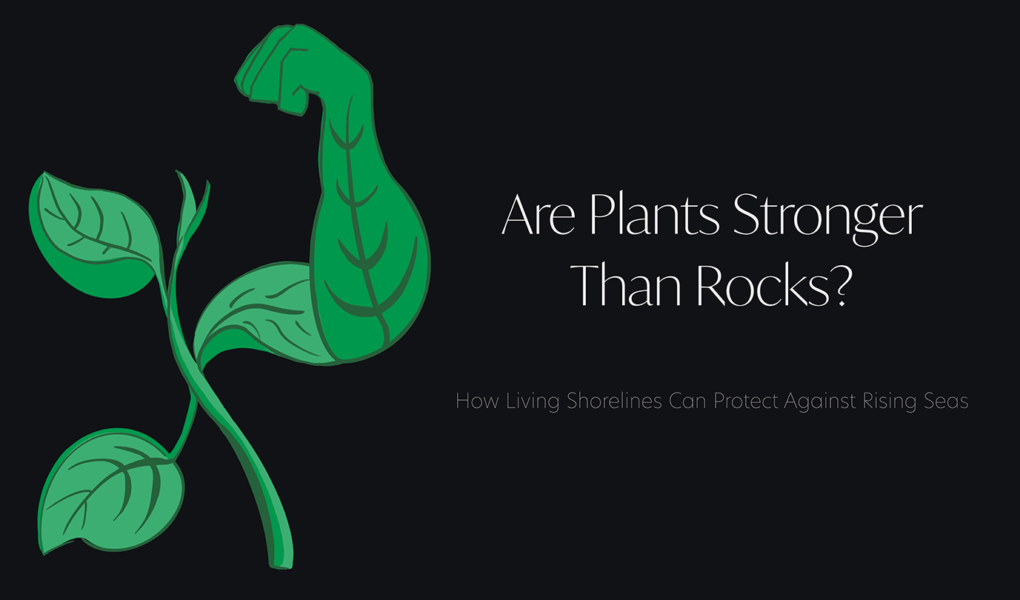Abstract
As global temperatures rise to record highs, one major consequence our planet must face is increasing sea levels. Rising seas threaten coastal communities and small islands through erosion of their land. To prevent further damage, engineers are experimenting with various defense methods such as building large structures and planting vegetation. Man-made defenses, such as seawalls and rock revetments, are effective at minimizing damage from waves, however, unnatural structures lack resilience and hinder marine ecosystems. Natural defenses, known as living shorelines, have the capability to simultaneously benefit ecosystems, improve water quality, and absorb wave energy, although they may not be substantial enough in high energy conditions. When used in combination, hard and soft defenses could be the dynamic solution needed to solve the problem of eroding land.
Introduction
Imagine growing up near the ocean, perhaps in a small island country, and your family operates a local fishing company. Now imagine you are forced to leave because your house has flooded, the water supply has been contaminated with saltwater, and tropical storms make it difficult to import supplies. You must leave everything you know behind, move to an unfamiliar country, and find work in a new industry. This is a reality for coastal residents worldwide due to sea level rise.
Global sea level rise causes a domino effect that first starts with land erosion, and continues with resource droughts, extreme weather patterns, and economic distress [1]. To prevent this from happening, engineers will need to revisit methods of shoreline protection. Where walls have failed in the past, plants have the potential to fill in those gaps. Otherwise known as living shorelines, barriers consisting of living organisms may be the key to protecting coastal communities.1
The Cause of Sea Level Rise
Sea level rise is a result of the increased temperatures occurring worldwide, known as global warming. The phenomenon that causes Earth’s temperature to increase is known as the greenhouse effect. A greenhouse works by trapping heat from the sun within a boundary, so the items inside remain warm when the sun goes down and the outside temperature drops. Earth’s atmosphere constantly acts like a greenhouse, maintaining an average temperature of 59 degrees Fahrenheit [1]. We owe our lives to the greenhouse effect because without it, Earth would be uninhabitable. However, with the excessive emissions of greenhouse gasses from the use of dirty energy sources, the greenhouse effect is exacerbating climate change. Fossil fuels, such as petroleum, coal, and natural gasses, are known as dirty energy sources because converting them to usable energy emits harmful gasses, including carbon dioxide, methane, and nitrous oxide [1]. These gasses, logically nicknamed “greenhouse gasses,” cause our climate to warm beyond ideal temperatures by absorbing a large percentage of solar energy within our atmosphere, converting it into heat. The Natural Resources Defense Council reports that carbon dioxide levels have increased by 40%, methane by 150%, and nitrous oxides by 20% since pre-industrial times [1]. More greenhouse gasses means more heat will be trapped within our atmosphere. At our current accelerating rate of greenhouse gas emissions, we face a predicted increase of 2.7 degrees Fahrenheit above pre-industrial levels within 10 to 30 years [1].
Increased temperatures contribute to rising sea levels through melting ice caps. When Earth’s temperature rises, the items on its surface also increase in temperature, namely the massive ice caps of Greenland and Antarctica. As a result, meltwater is pushed into the oceans, and sea levels rise. Thermal expansion is another contributor to rising seas. Thermal expansion says that matter takes on a higher volume at higher temperatures within a given phase. Therefore, when water increases in temperature, it expands and forces global sea levels to rise and encroach on coastal land. The National Oceanic and Atmospheric Association revealed that sea level has risen between 8 and 9 inches (21 to 24 centimeters) since 1880 [2]. Approximately one third of that increase occurred in the last 30 years, as seen in Figure 1, indicating that the rate of sea level rise is accelerating and will likely continue to accelerate if global temperatures are not reduced [2]. To put this into perspective, a coastal flooding study predicts that a global sea level rise of just one foot would increase the number of “chronically inundated communities” in the United States from 90 to 170 [3]. One foot of sea level rise could easily be a reality within the next century, therefore, learning to protect our shorelines is a necessity.

Figure 1. Global sea level rise [2].
Who is at risk?
Sea level rise threatens all communities in close proximity to water. These communities face different challenges based on their circumstances, however, all are vulnerable to tropical storms, flooding, and freshwater contamination [2]. Small island states risk losing their entire island to the sea, whereas large countries with highly populated coastal regions must decide whether to relocate or chance living near eroding land. Approximately 40% of United States’ residents live in “high population-density coastal areas” [2]. Even with an abundance of inland space, this is a massive amount of people to relocate, many of whom rely on coastal ecosystems for work.
Small islands lack the option of relocation altogether. Small island developing states, also known as SIDS, have a combined population of approximately 65 million, and one third of these small island residents live less than 5 meters above sea level [4]. They simply do not have enough high-lying land to take refuge on. The country of Tuvalu, for example, has a total area of 26 km spread over nine islands, as seen in Figure 2. Although SIDS are facing the most pressing repercussions from climate change, they are responsible for less than 1% of global carbon emissions [4]. With such little contribution to the problem, is it fair to rely solely on the affected people to find a solution? Even if deemed fair, it is unreasonable to think that a change in their greenhouse gas emissions will have any significant impact on global climate. Without an international agreement to reduce greenhouse gas emissions worldwide, coastal residents must accept the inevitable, and find a way to defend their land from encroaching seas.

Figure 2. Map of Tuvalu [11].
Defense Methods
Methods of coastal protection fall into two categories: hard and soft defenses. Hard defenses are man-made physical barriers that separate land and water, such as rock revetments and seawalls [3]. Hard defenses have often been the go-to strategy to diminish the impact of waves. In the United States, 14% of all coastlines have been “armored” using hard defense strategies [3]. Although large physical structures may seem like the best solution to rival the immense strength of our oceans, they have limitations. The first and most prominent being that hard defenses do not reduce wave energy, they divert it to other areas [3]. If we consider the possibility that these other regions may not be protected by any defense, hard defenses can inadvertently do more damage than protection. Another concern is that hard defenses will fail without proper maintenance. Much like coastal land is at risk of erosion, seawalls can erode at the base, compromising the entire structure [3]. Hard defenses also threaten aquatic ecosystems by separating organisms from necessary resources, thus hindering biodiversity [3]. A loss of biodiversity impacts both marine animals through the food chain, and humans by diminishing the food supply and threatening the fishing industry.
Soft defenses use natural materials, such as reefs, salt marshes, mangroves, and vegetation to defend against wave energy by absorbing it [3]. Instead of separating land from water, living shorelines connect the two to simultaneously prevent erosion and benefit the ecosystem. In calmer environments, salt marshes are generally the best choice because they absorb water and can be reinforced with rocks, oysters, or wood [3]. Mangroves perform similarly, using deep roots to anchor themselves and break up waves [3]. Soft defenses can be used on their own, shown in Figure 3, or in combination with hard structures, shown in Figure 4 [5].

Figure 3. Examples of living shorelines [10].

Figure 4. A range of soft to hard defenses [5].
Soft defenses offer unique capabilities due to their “biotic components” [6]. Soft defenses are living, and therefore can offer dynamic solutions to a dynamic problem. For starters, plants grow. As roots grow downward and leaves grow upward, shorelines are further stabilized and additional wave energy can be dissipated [3]. The National Oceanic and Atmospheric Administration has found that “fifteen horizontal feet of marshy terrain” can absorb fifty percent of wave energy [3]. If the growth of these plants can outpace the rise of sea level, it is reasonable to believe that they can be a long term solution. In places where hard defenses already stand, using soft defenses to reinforce them could be a potential solution instead of removing what currently exists. With the addition of a living element, hard defenses would better support ecosystems, absorb a portion of wave energy, and require less maintenance.
Environmental Benefits
Soft defenses can benefit the surrounding community by fostering ecosystem growth. Soft defenses are made from materials that animals naturally inhabit, so the addition of living shorelines offers more space for fish and marine organisms to occupy [5]. This produces a larger food supply for humans and animals higher on the food chain. Living shorelines have also proven to advance water quality through nutrient removal [7]. An excess amount of nutrients, such as nitrogen, in bodies of water is known as eutrophication. During eutrophication, algae forms on the surface of water and causes marine animals to die from lack of oxygen [7]. Higher water quality is in humans’ best interest as well, as consumption or contact with excess nutrients in water can have negative health implications. A study conducted in North Carolina discovered that living shorelines, specifically salt marshes and oyster reefs, increase the capacity for denitrification, which is “a globally important microbial pathway that removes bioavailable [nitrogen] from terrestrial and aquatic environments” [7]. The results of the study showed that denitrification rates in living shorelines ranging from zero to seven years old were greater than 50%, indicating nitrogen removal, and were consistently increasing [7]. This data proves that soft defenses can accomplish more than just their intended purpose. Soft defenses can benefit society in addition to reducing erosion.
Resilience
Climate change and rising seas are continuously changing systems that will require dynamic solutions. Engineers must ask themselves, how will this shoreline defense system adapt to changing conditions? Unlike hard defenses that require upkeep, living shorelines are able to grow and adjust with rising seas. The key to marsh growth is the collection of sediment from the surrounding water and land [6]. Sediment collection, the opposing process of erosion, occurs when plants trap organic matter in their leaves and roots [6]. As seen in Figure 5, sediment collection elevates the surface of the marsh, which increases its vertical height and allows it to retreat upward. This further stabilizes the shoreline.

Figure 5. Living shorelines adapting to rising sea levels [6].
Hard defenses can hinder the ability for a living shoreline to accumulate sediment, as they physically separate the spaces in front and behind them [6]. Although it may be easiest to add living shorelines to pre-existing hard defenses, a loss of resilience may outweigh convenience.
Success Thus Far
A study conducted along the coastal inlets of the Pacific Northwest, supports the argument for removal of existing hard structures. Across ten locations, beaches were separated into three conditions for a total of thirty test sites. One section of the beach had previously built seawalls, another section replaced seawalls with living shorelines, and the final section was left natural[8]. Data was collected to measure beach wrack accumulation, defined as “algae, eelgrass, and terrestrial sources”, which is a fundamental piece of a healthy beach ecosystem [8]. The regions where beach wrack accumulation was most numerous should theoretically have the strongest ecosystems. It was found that beach wrack percentages were higher in the areas where hard defenses had been removed and replaced than in areas where hard defenses remained [8]. However, percentages were the highest in areas that were natural and defenseless [8]. It stands to reason that natural processes, such as beach wrack accumulation, are most successful in natural conditions. Although leaving shorelines unaltered will not solve the problem of increasing sea level, the most natural of options will often be the best strategy in terms of ecosystem sustainability.
In some regions, the most natural option that is also effective may have to include both hard and soft aspects. Living shorelines have shown weaknesses towards high energy conditions, such as boat wake, making it necessary to explore hybrid variations [9]. The National Estuarine Research Reserve System tested a combination method of defense along the Atlantic Intracoastal Waterway in northeast Florida that had promising results. The design, seen in Figure 6, utilizes “semi-permeable wooden breakwalls” and “cages filled with oyster shells (gabions)” followed by salt marshes [9].

Figure 6. A hybrid method of shoreline protection [9].
The goal of this design was to break up wave energy while using materials that allow for ecosystem success. The gabion, or caged oyster, layer accomplishes this by fostering more oyster growth[9]. The wooden breakwall supports ecosystems better than a concrete or rock breakwall because it allows substances to pass through instead of forming an impenetrable boundary [9]. This aids salt marsh expansion because sediment collection is able to occur [9]. The design was also successful in dissipating wave energy. The results of the experiment showed shoreline stability and salt marsh expansion where this design was used, compared to two meters of shoreline erosion in places left unaltered [9]. While this design may not be 100% natural, it gives very effective results.
The Future of Living Shorelines
A flexible approach must be taken to design living shorelines. When a combination of hard and soft defenses is necessary due to a high energy environment, the location of the shoreline must first be considered to best accommodate the existing ecosystem. Living shorelines will vary according to their environment, thus requiring the attention of engineers worldwide. With the rate of sea level rise increasing exponentially, urgency will be of utmost importance. The longer shorelines are left unarmored, more and more precious land will be lost to the sea. In small island states, a small amount of land may be the difference between residents remaining in their home or facing forced relocation. Although not a flawless solution, living shorelines can protect fragile land while the knowledge of climate change and rising seas advances. With environmental benefits and resilience also considered, living shorelines are the future of shoreline defenses.
References
[1]M. Denchak, “Greenhouse Effect 101”, NRDC, 2021. [Online]. Available: https://www.nrdc.org/stories/greenhouse-effect-101. [Accessed: 16- Sep- 2021].
[2]R. Lindsey, “Climate Change: Global Sea Level | NOAA Climate.gov”, Climate.gov, 2021. [Online]. Available: https://www.climate.gov/news-features/understanding-climate/climate-change-global-sea-level. [Accessed: 16- Sep- 2021].
[3]J. Bennington-Castro, “Walls won’t save our cities from rising seas. Here’s what will”, NBC News, 2021. [Online]. Available: https://www.nbcnews.com/mach/science/walls-won-t-save-our-cities-rising-seas-here-s-ncna786811. [Accessed: 16- Sep- 2021].
[4]L. Mead, “Small Islands, Large Oceans: Voices on the Frontlines of Climate Change”, International Institute for Sustainable Development, 2021. [Online]. Available: https://www.iisd.org/articles/small-islands-large-oceans-voices-frontlines-climate-change. [Accessed: 16- Sep- 2021].
[5]”Living Shorelines – NOAA Habitat Blueprint”, NOAA Habitat Blueprint, 2021. [Online]. Available: https://www.habitatblueprint.noaa.gov/living-shorelines/. [Accessed: 16- Sep- 2021].
[6]M. Mitchell and D. Bilkovic, “Embracing dynamic design for climate‐resilient living shorelines”, Journal of Applied Ecology, vol. 56, no. 5, pp. 1099-1105, 2019. Available: 10.1111/1365-2664.13371 [Accessed 15 September 2021].
[7]K. Onorevole, S. Thompson and M. Piehler, “Living shorelines enhance nitrogen removal capacity over time”, Ecological Engineering, vol. 120, pp. 238-248, 2018. Available: 10.1016/j.ecoleng.2018.05.017.
[8]J. Toft, M. Dethier, E. Howe, E. Buckner and J. Cordell, “Effectiveness of living shorelines in the Salish Sea”, Ecological Engineering, vol. 167, 2021. Available: 10.1016/j.ecoleng.2021.106255.
[9]”Re-Engineering Living Shorelines for High-Energy Coastal Environments – NERRS/NSC(NERRS… | InPort”, Fisheries.noaa.gov, 2021. [Online]. Available: https://www.fisheries.noaa.gov/inport/item/47682. [Accessed: 16- Sep- 2021].
[10] J. D. Valck and J. Rolfe, “Linking water quality impacts and benefits of ecosystem services in the Great Barrier Reef,” Marine Pollution Bulletin, 15-Mar-2018. [Online]. Available: https://www.sciencedirect.com/science/article/pii/S0025326X18301620#f0015. [Accessed: 10-Oct-2022].
[11] “What are the key facts of Tuvalu?,” Answers, 01-Oct-2020. [Online]. Available: https://www.mapsofworld.com/answers/geography/what-are-the-key-facts-of-tuvalu/. [Accessed: 10-Oct-2022].




